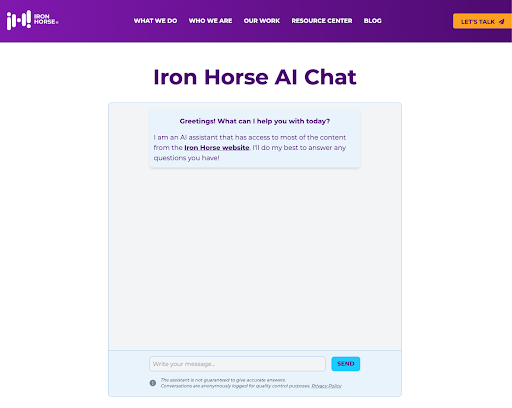Blog

By the time you’re reading it, this blog is already out of date.
It’s not my fault (or yours), but since I started the first draft, Google detailed their next AI steps at I/O 2024, OpenAI launched ChatGPT 4.o, Scarlett Johansson (and her lawyers) got involved, and the space just keeps evolving faster than ever.
The speed of innovation makes writing a blog about Iron Horse’s stance on the current state of AI rather complicated. “Current” is a moving target, but here’s a look at where we think AI is headed— and what that means for our company and our clients.
Generative AI is already reshaping digital marketing.
I’m convinced that Generative AI is going to fundamentally shift the way your customers discover you. There are a lot of reasons I feel this way, but the biggest one is pretty simple: it’s already working on me.*
My behavior as a user and consumer has changed dramatically since the introduction of powerful generative AI tools like ChatGPT, Perplexity, and Claude. Instead of starting my research process by visiting websites or scrolling through search results, I now begin by engaging with these AI assistants. I tap into their knowledge bases, leverage their analytical capabilities, and use them as intelligent sounding boards.
We’re witnessing a fundamental shift in how users access and consume information. Major tech giants like Google are rolling out generative AI offerings like AI Search Overview, while startups like Perplexity are rethinking search and discovery entirely.
In the B2B world specifically, my bold prediction is that the traditional buying journey involving dozens of touchpoints will get streamlined and concentrated. Buyers will be able to obtain and process the information they need far more efficiently using AI assistants. Rather than starting a search from scratch with a search engine, I expect that we’ll see users leverage GenAI platforms to do that heavy lifting for them, then use those rough sketches to track down the specific information they’re looking for.
In fact, we’re already seeing leads come in who discovered our company, Iron Horse, through ChatGPT interactions. Just as the smartphone revolution forced companies to rapidly adapt to a mobile-first world, this emerging generative AI disruption will necessitate a similar pivot. To stay relevant, companies must realign their strategies to meet buyers where they now reside—in AI-powered information interfaces.
Marketers have to reshape our strategies to meet GenAI.
The implications of this generative AI disruption are broad and varied for marketers. We can no longer rely solely on traditional content delivery mechanisms like websites, emails, and ads. Personalization must now extend beyond just tailoring messaging – we also need to adapt to users’ preferred content modalities, whether that’s chat, voice assistants, or other interfaces powered by AI.
As marketers, we’ve traditionally sought to control the narrative around our products and services. But in this new world where users can have AI tools like ChatGPT rephrase and repackage our concepts on the fly, that control is diminished. For example, I asked ChatGPT “should i hire iron horse?”, and it included this list of benefits in its response:
Expertise: They have specialized knowledge in marketing technology, which could benefit your marketing strategies.
Services Offered: They provide a range of services including demand generation, marketing automation, and account-based marketing.
Clientele: Review their portfolio to see if they’ve worked with companies similar to yours or in your industry.
Nothing too bad there, but if our potential clients are leaning on ChatGPT to help start their search process, we need to work on getting the platform to surface results that speak a little more to our target demographic.
GenAI has a place in your workflow… if you’re honest about the current state.
While generative AI tools like ChatGPT undoubtedly represent a paradigm shift, we’re still in the relatively early stages of this movement. The marketing from the companies behind these tools often paints an aspirational picture of AI that can produce perfect, ready-to-publish content with little to no human involvement. However, the reality is that today’s generative AI typically requires significant prompting, curating, and revising to connect with your audience.
Even with thoughtful, iterative prompting, AI-generated output can still contain factual errors, logical inconsistencies, biases, or other flaws that require human oversight and polishing. The recent example of the Humane AI pin demonstrates the gap between marketing and reality— an AI-powered product that looked incredible in the demo videos… just didn’t really work by the time it got into reviewers’ hands.
As businesses look to fold generative AI into their workflows, it’s crucial to have a realistic assessment of the current state of the technology’s strengths and limitations. Building strategies around the marketed hype rather than the actual capabilities can lead to frustration and suboptimal results. The most successful approaches will take the time to truly understand where today’s AI shines and where it still needs supportive human judgment.
We’re getting hands-on to push the limits.
At Iron Horse, we aren’t just theorizing about the potential of generative AI – our Innovation Labs team is getting hands-on. Through a range of forward-looking projects, we’re exploring practical applications of this technology focused on driving productivity and enhancing the buyer experience.
This commitment to experimentation has already borne fruit in the form of early prototypes. For example, we’ve developed an AI-powered chat assistant that allows visitors to our website to interactively learn about our services through a conversational interface. We encourage you to try it out and let us know what you think of this AI-driven approach to discovery.

But we didn’t stop at just text chat. We’ve also innovated with an Iron Horse AI-powered voice assistant that provides an interactive, conversational experience for audio/voice learning about our company’s offerings. Feel free to give it a try and share your feedback on this AI-powered exploratory experience.

For us, getting firsthand experience actually building upon generative AI has been invaluable. It’s allowed us to realistically assess the current state of the technology, while continuing to push its boundaries through iterative prototyping. We’re excited to keep innovating in this space and shaping how AI can create more natural, personalized engagement throughout the buyer’s journey.
The Iron Horse Insight.
The rise of powerful generative AI capabilities represents a seismic shift that is already transforming user behavior and buyer expectations. While we’re still in the relatively early stages of this movement, the profound impact is unmistakable. At Iron Horse, we see this as an opportunity for innovation.
The specifics of this innovation are shifting rapidly (again, a lot has happened since I started this draft), but we’re making the commitment to rolling with the punches.
We aren’t sure what marketing is going to look like five years from now, but we’re sure it’s going to look different.
* At Iron Horse, we never use AI to generate final, un-edited copy. We do use AI to more efficiently create excellent writing. AI-assisted tasks may include brainstorming, pushing past writer’s block and getting to a first draft more quickly. All final copy is always written according to our expertise and best practices. Any input by AI is thoroughly analyzed and adjusted to produce the best result possible.
Subscribe to our blog.
Get unstuck with the most interesting business ideas and our insights delivered to your inbox.